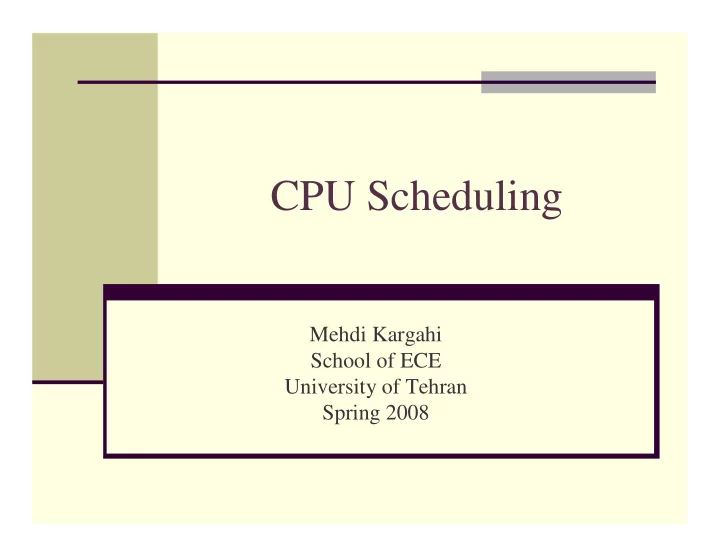

CPU Scheduling Mehdi Kargahi School of ECE University of Tehran Spring 2008
CPU and I/O Bursts M. Kargahi (School of ECE)
Histogram of CPU-Burst Durations M. Kargahi (School of ECE)
When CPU Scheduling Occurs Running process switches to wait state 1. � I/O request � Waiting for termination of one of the child processes Running process switches to ready state (timer interrupt) 2. Waiting process switches to ready state (I/O completion) 3. Running process terminates 4. Under non-preemptive scheduling: 1 and 4 are legal scheduling points Under preemptive scheduling: 1 through 4 are legal Scheduling points M. Kargahi (School of ECE)
Preemptive Scheduling � Inconsistency of shared data should be controlled � During the processing of a system call or doing I/O, preemption may result inconsistency � Most kernel codes are non-preemptive � These portions of code with disabled interrupts do not occur very often and typically contain few instructions � Problematic for real-time systems � Linux RedHat 2.6 kernel is preemptable M. Kargahi (School of ECE)
Dispatcher � The dispatcher function includes � Switching context � Switching to user mode � Jumping to the proper location in the user program to restart that program � Dispatch latency must be short M. Kargahi (School of ECE)
Scheduling Criteria � Some criteria for selecting an scheduling algorithm are as follows: CPU utilization 1. Is 100% good for utilization? � Normally between 40% and 90% � Throughput 2. Long processes have small throughput � Turnaround time 3. Includes loading, waiting in ready queue, execution, I/O, … � Waiting time 4. Response time 5. � Maximizing 1 and 2 � Minimizing 3,4, and 5 (e.g., minimizing the maximum response time) M. Kargahi (School of ECE)
Scheduling Algorithms � FCFS: First-Come First-Served � AWT: 17 � Generally, the AWT is not minimal � FCFS is not proper for time-sharing M. Kargahi (School of ECE)
Scheduling Algorithms � SJF: Shortest-Job-First � AWT: 7 (minimal) � Proof ? � How we can find the length of CPU-burst of jobs? M. Kargahi (School of ECE)
Exponential Average for CPU-Burst Prediction 0 ≤α≤ 1 M. Kargahi (School of ECE)
Scheduling Algorithms � SRTF: Shortest-Remaining-Time-First � AWT: 6.5 � AWT (SJF): 7.75 M. Kargahi (School of ECE)
Scheduling Algorithms � Priority Scheduling � Each process has a priority (e.g., 0..127) � Equal-priority processes are scheduled according to another algorithm, e.g., FCFS M. Kargahi (School of ECE)
Priority Scheduling � Starvation (Indefinite blocking) � E.g., SJF � IBM 7094 at MIT � Duration of running a low-priority process:1967- 1973 � Solution � Aging: gradually increasing the priority of processes (according to timer interrupts) that wait in the system for a long time M. Kargahi (School of ECE)
Scheduling Algorithms � RR: Round-Robin � Preemptive � Time-slice, time-quantum, time-slot (according to timer interrupts) � Ex.: q=4 � AWT: 5.66 M. Kargahi (School of ECE)
Round-Robin � When time quantum becomes very large, RR degenerates to FCFS � When time quantum becomes very small, RR is known as processor sharing (CS overhead becomes more important) � CS overhead should normally be 0.01% to 0.1% � A rule of thumb � 80% of CPU bursts < time quantum M. Kargahi (School of ECE)
Scheduling Algorithms � Multilevel Queue Scheduling � Absolute priority (starvation) � Time-slicing among queues (e.g., 80% for RR among foreground processes and 20% for FCFS serving of background processes) M. Kargahi (School of ECE)
Scheduling Algorithms � Multilevel Feedback Queue Scheduling � Aging can also be added M. Kargahi (School of ECE)
Scheduling Algorithms � Multilevel Feedback Queue Scheduling � Parameters � Number of queues � The scheduling algorithm for each queue � How to upgrade the priority of a process � How to downgrade the priority of a process � Specifying the queue to which a process should be added to get service M. Kargahi (School of ECE)
Multiple-Processor Scheduling � Asymmetric multiprocessing � Master server does scheduling decisions, I/O processing, … � Symmetric multiprocessing (SMP) � Each processor is self-scheduling � Each processor may have its own ready queue or they may share a common ready queue M. Kargahi (School of ECE)
Symmetric multiprocessing (SMP) � Processor Affinity � Migration � � cache invalidating of the source processor � � cache re-populating of the target processor � Soft affinity � OS tries to avoid migration but cannot guarantee � Hard affinity � OS guarantees that a process will not migrate M. Kargahi (School of ECE)
Symmetric multiprocessing (SMP) � Load balancing � Push migration � Checking periodically with a specific task � When imbalance is detected, the load of overloaded processors are pushed to less-busy processors � Pull migration � An idle processor pulls a waiting task from a busy processor M. Kargahi (School of ECE)
Symmetric Multithreading (SMT) � SMP runs several threads concurrently on multiple physical processors � SMT runs several threads concurrently on multiple logical processors (hyper-threading technology in Intel processors) � HW simulates one or more physical processors as a number of logical processors for the OS M. Kargahi (School of ECE)
Symmetric Multithreading (SMT) � OS does not need to know if it is running on a SMT � But, if is aware of SMT, it may make better decisions � E.g., running two threads on two logical CPUs on different physical CPUs rather than one such CPU M. Kargahi (School of ECE)
Thread Scheduling � Process-Contention Scope (PCS): � Competition for the CPU among the threads belonging to the same process (thread library) � System-Contention Scope (SCS): � Competition for the CPU among all threads in the system (OS CPU scheduler) M. Kargahi (School of ECE)
Recommend
More recommend